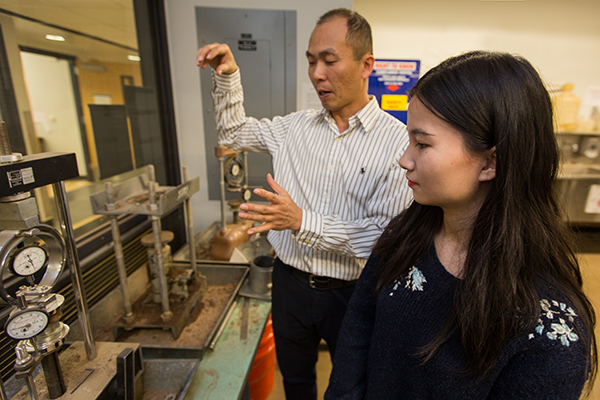By Myles Schrag and Abigail Gripman
University Marketing
At Northern Arizona University, student success and research that can change the world are high on the list of goals. At the annual Undergraduate Expo, those goals go hand in hand as undergraduate students from all disciplines throughout campus present the research they’ve taken on during their time at NAU.
The expo runs from April 19-29 and includes Educate2Act, a conference focusing on issues in the field of education; the inaugural Student Water Symposium and a Student Artist Series. The Undergraduate Symposium, which takes place from 9 a.m. to 4 p.m. April 27, is the largest event; more than 700 undergraduate students will present their research to judges, alumni, faculty members and community members.
“Not many undergraduates get the chance to participate in such a prestigious event,” said Tina Zecher, senior program coordinator for the Office of Undergraduate Research & Scholarship. “It demonstrates a commitment to their field of study that reflects positively on the student’s ability to think critically about current ideas and issues.”
For a list of all the events, visit the Undergraduate Expo’s website.
Read on to learn about a few of the researchers who will present their work at the symposium. You can also learn more about other projects, such as an interior design major who wants to use biomimicry to create homeless shelters and a forensics student whose research may help the medical examiner identify bodies, both of whom received Hooper Undergraduate Research Awards.

Karla Arteaga Cortes, art and secondary education major
Art can transform teaching.
Through her research and practice, Karla Arteaga Cortes believes that visual art creates a more connected classroom—between teacher and students, and between students and lesson, especially on sensitive topics and in intercultural settings.
“When students can actually feel like they are heard, then naturally that reflects in how they treat you” the senior art education major said. “Students really do appreciate it when you take the time to break things up and give them a break from all this auditory, textual, everyday use. They want something visual, kinesthetic. They need that. It’s human. The three things that make us very different from animals are language, culture and art.”
Cortes’ research focuses on creating free spaces in the classroom for counterhegemonic actions. It is a reimagining of power dynamics—a recognition that whatever the subject being taught, social justice must be part of the discussion. She has been a teaching assistant and a student-teacher and English as Second Language specialist in public schools during her NAU career and presented her research at the Educate to Act conference.
She will carry that with her after graduation to Addis Ababa, Ethiopia, where she will co-teach art alongside an engineer and an architect, adding art to turn a STEM class into STEAM.
“I’m so humbled I was picked and am grateful for that opportunity,” she said. “When you’re doing research, it’s a lot of talk. For me, it was the coals to light the fire in what I want to do and to act. Research gave me the confidence in knowing that I am a human being who can think and learn.”
Ziyan Wu, environmental engineering major

The changing weather patterns brought by global climate change present unique challenges to civil engineers. NAU senior Ziyan Wu’s research will help engineers divert and control one of the planet’s most precious resources: water. Wu is using computer modeling to create a new Intensity-Duration-Frequency (IDF) curve. Engineers use the IDF curve to build infrastructure, like storm sewers and drains, that can accommodate expected rainfall patterns, patterns that are changing dramatically as the planet warms.
Wu, an international student from China who is majoring in environmental engineering, started doing research during her second year at NAU, when civil engineering professor Amin Mohebbi invited her to participate in engineering research.
“This was the first step for me, the critical step for me,” she said.
The process of researching also gave Wu a new career direction; her goal now is to become a professor so she can continue to do research and instruct students.
“The most important thing I’ve learned from doing research is how to learn something on my own,” she said. “I’d like to inspire other students to get involved in research.”
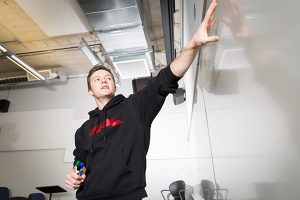
Tanner Rosenberg, math and physics major
Junior Tanner Rosenberg is working to mathematically describe gene mutation. His pure math research project will have real-world biology applications.
“We have gene sequences in our DNA, and the most common way they can be mutated is called a reversal where a chunk gets pulled out, flipped over, and put back in so all the genes are upside down and backwards,” he explained.
To set up his research, he numbered each gene and marked them as right side up or upside down. From a biological perspective, that information can show the distance between two gene sequences and evolutionary distance.
“Using that as our mathematical model we can mutate them with these reversals. We’re looking at how messed up the gene sequence can get so we can see the greatest number of reversals it takes to mutate it into something else.”
As an undergrad, Rosenberg presented his research at the largest conference of mathematicians in the world held in San Diego. Inspired by the work his professors were doing, he got involved in research as a sophomore and added a math major as a result. Between his research and preparation from professors, Rosenberg said he has confidence that he’ll be ready to enter the job market.
“Research especially forces you to find your own answers, overcome obstacles and try something else,” he said.
Amalee Nunnally, microbiology
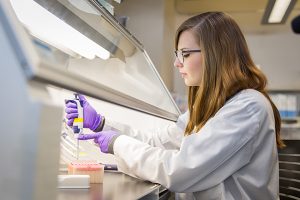
Like a police detective, Amalee Nunnally is looking for a killer. But instead of a blue uniform and badge, Nunnally wears a white lab coat. A junior microbiology major (she changed her major because she liked the research so much), Nunnally works to detect a pathogen, Clostridium difficile, in the Flagstaff soil. Clostridium difficile is common worldwide and in severe cases can cause death. By gene sequencing the pathogens she finds in soil samples from 50 locations throughout Flagstaff, Nunnally can match them with those found in Flagstaff hospital patients and trace the source of Clostridium difficile in these patients.
Her work in the Pathogen and Microbiome Institute gave Nunnally opportunities she never imagined possible for an undergraduate and uncovered in her a passion for research.
“I always envisioned that as an undergraduate, I’d only be somebody’s research assistant, washing dishes and taking out trash and doing those kinds of things,” she said. “But the opportunity they give us here is unreal. I am working with very expensive reagents and very important samples.”
She plans to go to graduate school and then make a career of biological research. This is her second year presenting at the symposium; she’s also presented at a number of national conferences on anaerobic bacteria.
“The clinical aspect of the project is fascinating to me and provides instant gratification,” Nunnally said. “You know about these patients and they’re suffering and you can see your research making a difference immediately.”
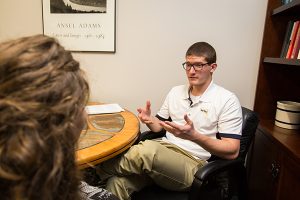
Jacob Coutts, psychological sciences
To understand human behavior, you need to know your numbers. That intersection of social science and statistics fuels Jacob Coutts to look for mediators that influence a person’s self-compassion.
“We posit that greater self-compassion leads to greater sense of self-concept clarity,” the NAU senior said. “You know yourself better when you are self-compassionate because you’ve worked through your faults, your flaws. It’s composed of mindfulness, common humanity and self-kindness. When you express all three of those, you have a high level of self-compassion. I think it’s one of the ways of the future in research. The reason I like that study is because I get a greater look at statistical analyses like mediation and moderation. It’s the most statistically savvy project I’m working on right now.”
Coutts has worked on many. To him, psychology and math are intertwined and a constant source of discovery. It is why, as an undergraduate, he has researched a construct that has only been studied for 15 years. It is why he has worked in four labs and been involved in projects analyzing anxiety, grit and sexuality.
Coutts will begin a graduate career in quantitative psychology in the fall armed with a strong research foundation and a belief that all undergraduate students should be involved in research.
“Something that is really great about research is you can do it either by yourself or on this team,” he said. “This team can cross universities, cross disciplines. It’s not uncommon to see biologists and psychologists and all these different areas working together. You get this really great cross-pollination of ideas and innovation. I think with research you’re on the forefront of groundbreaking ideas, whether that’s in biology or psychology or chemistry. It’s this unexplored world for a lot of people that I think everyone should be in.”
Shelby Hutton, general biology
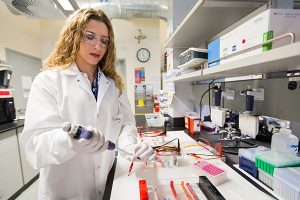
Shelby Hutton pours fleas from Madagascar out of a vial, each hanging on to the others in a huge ball. Yes, the NAU junior biology major says, insects can be “gross,” but she is fascinated by the dynamic and complex role they play as vectors carrying plague to human hosts: “I think diseases are really cool, in a sadistic way, the way they infect people. It’s an interesting system, and the fact that it does affect so many people inspires me to do research on these bugs.”
Painstakingly, Hutton studies 80 fleas. She discovers that each one carries the same genetic mutation, which enables them to resist pesticides and live on to potentially spread plague.
Hutton’s job is to create assays—experiments—to screen fleas so that the institute in Madagascar that partners with NAU’s world-renowned Pathogen and Microbiome Institute (PMI) can develop better solutions to control the flea population.
At PMI, Hutton researches fleas and microbes, some of the tiniest living things. By doing so, she seeks solutions to some of the world’s biggest problems—a rare opportunity for an undergraduate and one that helped her decide to be a veterinary microbiologist.
“My research experience has defined what I want my career to be. Many places that hire undergraduate researchers have them cleaning dishware. We get to be almost in charge of some of these projects. We’re the ones who are in the lab doing the data generation. It gives you a sense of ownership of what you’re doing.”
Last week Hutton was named one of three Goldwater Scholars at NAU.
